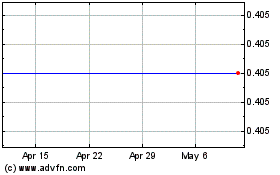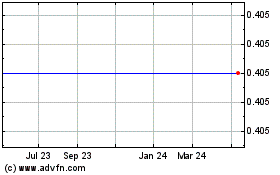- ATB-346 demonstrates superiority to
placebo in reducing osteoarthritis pain -
- ATB-346 is more potent than expected;
lowest effective dose still to be established -
- Antibe plans pivotal Phase 2/3 adaptive
registration trial -
Antibe Therapeutics Inc. (TSXV: ATE, OTCQB: ATBPF) is pleased to
announce that its lead drug, ATB-346, met the primary endpoint in
the Phase 2B dose-ranging, efficacy study. Both the 250 mg and 200
mg doses of ATB-346 demonstrated superiority to placebo in reducing
osteoarthritis (“OA”) pain with a high level of statistical
significance. The 150 mg dose of ATB-346, although not powered for
statistical significance, demonstrated more potency than expected
and the lowest effective dose is still to be established. The drug
was safe and well tolerated during this study. The Company is
planning a pivotal Phase 2/3 randomized, controlled trial with an
adaptive design that will define the lower end of the dose-response
curve.
“We are pleased that our drug provided excellent pain relief to
the patients in the study,” remarked Dan Legault, Antibe’s CEO.
“The success of this study is a worthy complement to the GI safety
results already in hand. With the extensive learning that these
Phase 2 studies have provided, we have a clear path forward
including an opportunity to lower the dose further. Through an
adaptive registration trial we can maintain our clinical and
commercial timelines, and focus on large market partnering.”
A total of 385 patients with osteoarthritis (OA) of the knee
were randomized to either placebo or ATB-346 administered once
daily: 250 mg, 200 mg or 150 mg. The primary endpoint in the study
was the change from baseline in the WOMAC pain subscale score as
measured at the end of the 14-day treatment period. The 250 mg and
200 mg doses were powered for statistical significance and the 150
mg dose was powered to only observe an efficacy response.
ATB-346 demonstrated superiority to placebo at doses of 250 mg
(p-value of 0.01) and 200 mg (p-value of 0.007). Similar efficacy
was observed between these doses, suggesting that the upper range
of the dose-response curve has been reached. The 150 mg dose
demonstrated a robust efficacy response and had it been
equivalently powered to the other treatment arms, the Company
believes it would have achieved statistical significance. As such,
the lower portion of the dose-response curve remains to be
established.
In addition, both the 250 mg and 200 mg doses of ATB-346
demonstrated a highly statistically significant reduction in the
WOMAC stiffness subscale score (p-value < 0.001 for both doses)
and both doses were superior to placebo in the WOMAC difficulty
performing daily activities (DPDA) subscale score (p-value of 0.004
and 0.001, respectively). While not statistically powered, the 150
mg dose of ATB-346 nonetheless demonstrated a statistically
significant improvement in stiffness compared to placebo (p-value
of 0.03) and displayed an efficacy response in DPDA.
Adverse events typically associated with NSAID use, such as
dyspepsia, acid reflux and dizziness, were comparable across
placebo and all three treatment arms of ATB-346. There were very
few serious adverse events or events leading to withdrawal of
treatment. Only 1 out of 318 patients administered ATB-346 had
clinically significant, temporary liver transaminase elevations
(LTEs) during the 14-day treatment period. At the post-treatment
assessment (day 24), patients in the 250 mg, 200 mg and 150 mg
treatment arms had clinically significant, temporary LTE incidences
of 12.1%, 8.0% and 8.2%, respectively. It is standard for pain
trials to allow the use of other medications, commonly
acetaminophen. Acetaminophen use, especially in the post-treatment
assessment period, pre-existing liver conditions and concomitant
statin use were associated with a majority of the LTE incidents.
Accounting for these factors yields clinically significant,
temporary LTE incidence rates of 4.5%, 3.2% and 3.3%, respectively,
suggesting a liver safety profile for ATB-346 comparable to
commonly prescribed NSAIDs and well below that observed with
acetaminophen (39% clinically significant LTE incidence rate;
National Institutes of Health).
Joe Stauffer, Antibe’s Chief Medical Officer, commented, “I
joined Antibe to help set a new standard of safety and
effectiveness in the treatment of pain and inflammation. The
results of this study, in conjunction with the profound GI safety
results already demonstrated, indicate that we are on track to this
new standard in patient care. The LTEs will need to be considered
moving forward, but are manageable from a clinical perspective.
Given the robust upper portion of the dose-response curve, we
anticipate lower doses will be effective and further optimize the
safety profile of ATB-346.”
To establish the lowest effective dose of ATB-346, the Company
is planning a pivotal Phase 2/3 randomized, controlled trial with
an adaptive design. Antibe anticipates that this efficacy trial
will compare multiple doses of ATB-346 to placebo in OA patients
over a 12-week period. It is the Company’s intention to submit this
study to the U.S. FDA as a formal registration trial.
The clinical study was conducted by Veristat, LLC in 39 clinical
sites across Canada. David Vaughan, Antibe’s Chief Development
Officer, commented, “We would like to express our gratitude to the
Veristat team and the clinicians across the country for their
commitment and contribution to this well-run and successful
clinical trial.”
About ATB-346
ATB-346 is a hydrogen sulfide-releasing derivative of naproxen.
Nonsteroidal anti-inflammatory drugs (“NSAIDs”) are the most
commonly used therapy for osteoarthritis, but their use is
associated with a high incidence of gastrointestinal ulceration and
bleeding. NSAIDs are also widely used in conditions such as
rheumatoid arthritis, ankylosing spondylitis, gout, and general
pain reduction, with a similarly high rate of gastrointestinal
ulceration and bleeding. It is well-accepted that patients with
these conditions would benefit greatly from an effective,
non-addictive, GI-sparing anti-inflammatory/analgesic agent such as
ATB-346.
About Antibe Therapeutics Inc.
Antibe develops safer, non-addictive medicines for pain and
inflammation. Antibe’s technology involves the linking of a
hydrogen sulfide-releasing molecule to an existing drug to produce
an improved medicine. Antibe’s lead drug, ATB-346, targets the
global need for a safer, non-addictive drug for chronic pain and
inflammation. ATB-352, the second drug in Antibe’s pipeline,
targets the urgent global need for a non-addictive analgesic for
treating post-surgical pain, while ATB-340 is a GI-safe derivative
of aspirin. Citagenix Inc., an Antibe subsidiary, is a market
leader and worldwide distributor of regenerative medicine products
for the dental marketplace. www.antibethera.com.
Forward Looking Information
This news release includes certain forward-looking statements,
which may include, but are not limited to, the proposed licensing
and development of drugs and medical devices. Any statements
contained herein that are not statements of historical facts may be
deemed to be forward-looking, including those identified by the
expressions "will", "anticipate", "believe", "plan", "estimate",
"expect", "intend", "propose" and similar wording. Forward-looking
statements involve known and unknown risks and uncertainties that
could cause actual results, performance, or achievements to differ
materially from those expressed or implied in this news release.
Factors that could cause actual results to differ materially from
those anticipated in this news release include, but are not limited
to, the Company’s inability to secure additional financing and
licensing arrangements on reasonable terms, or at all, its
inability to execute its business strategy and successfully compete
in the market, and risks associated with drug and medical device
development generally. Antibe Therapeutics assumes no obligation to
update the forward-looking statements or to update the reasons why
actual results could differ from those reflected in the
forward-looking statements except as required by applicable
law.
View source
version on businesswire.com: https://www.businesswire.com/news/home/20200601005287/en/
Antibe Therapeutics Inc. Christina Cameron VP Investor Relations
+1 416-922-3460 christina@antibethera.com
Antibe Therapeutics (TSXV:ATE)
Historical Stock Chart
From Dec 2024 to Jan 2025

Antibe Therapeutics (TSXV:ATE)
Historical Stock Chart
From Jan 2024 to Jan 2025
